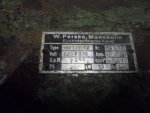I'm wanting it for resaw work.
I have a like of old cast things. My table saw is a wadkin ags, my metal lathe a smart and brown from the 1950s, donkey saw from the 1940s etc.
But I've got modern Japanese cnc kit also, so it's function rather than misplaced nostalgia.
I came close to buying a walker turner, but it was only one of the 14" ones and the resaw height was little better than I could do with the table saw, with a 12" blade.
I know very little about bandsaws, so I'm trying to find an unobtainable sweet spot of many things and wondering where to compromise.
I'd like -
*As much resaw height as I can get for the other compromises. Throat depth unimportant really.
*Preferance for old cast, but I won't be buying new whatever.
*As little floor space as possible
*I would like to be able to spend around £1k or less with, say, 6 months of looking for the right one.
*I don't want to be welding broken cast, but I don't mind fabrication / restoration.
Out of all of the above, resaw height is the most important. No point in buying if it won't do what I need.
I've been searching dominion, wadkin, startrite, walker turner etc but not really knowing one from the other.
Has anyone got any quick suggestions to add to my shortlist?
My £1k ish restoration price with the time searching probably translates to £2k items on eBay today, but, even still, I'm aware it won't be an easy set of criteria to match.
I'm really after pointers at this stage.
Thank you
Julian
I have a like of old cast things. My table saw is a wadkin ags, my metal lathe a smart and brown from the 1950s, donkey saw from the 1940s etc.
But I've got modern Japanese cnc kit also, so it's function rather than misplaced nostalgia.
I came close to buying a walker turner, but it was only one of the 14" ones and the resaw height was little better than I could do with the table saw, with a 12" blade.
I know very little about bandsaws, so I'm trying to find an unobtainable sweet spot of many things and wondering where to compromise.
I'd like -
*As much resaw height as I can get for the other compromises. Throat depth unimportant really.
*Preferance for old cast, but I won't be buying new whatever.
*As little floor space as possible
*I would like to be able to spend around £1k or less with, say, 6 months of looking for the right one.
*I don't want to be welding broken cast, but I don't mind fabrication / restoration.
Out of all of the above, resaw height is the most important. No point in buying if it won't do what I need.
I've been searching dominion, wadkin, startrite, walker turner etc but not really knowing one from the other.
Has anyone got any quick suggestions to add to my shortlist?
My £1k ish restoration price with the time searching probably translates to £2k items on eBay today, but, even still, I'm aware it won't be an easy set of criteria to match.
I'm really after pointers at this stage.
Thank you
Julian
Last edited:










































